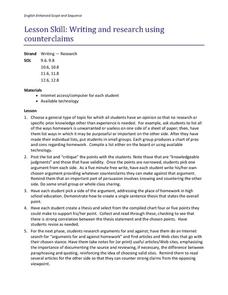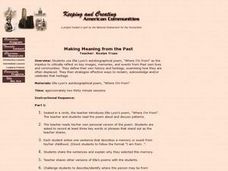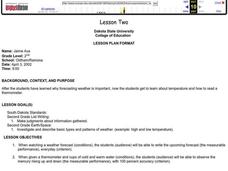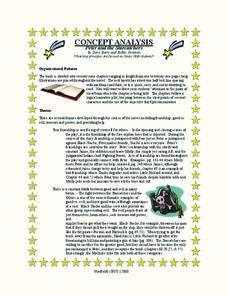Curated OER
What's My Point: Persuasive Writing
Why do readers need to know an author’s purpose? How do you figure out what that purpose is? Guide your pupils through a series of activities that show them how to identify various techniques and structures used in persuasive writing....
Virginia Department of Education
Writing and Research Using Counterclaims
Introduce your high school scholars as to how to use counterclaims in argument writing. Learners explore this skill with collaborative efforts and technology. Together they explore the pros and cons of homework and develop a thesis for...
Curated OER
Whittle, Whittle it Down: Summarizing
Middle schoolers summarize a one to two page article of informational text. They compose a summary according to the guidelines on the "Five Rules for Writing a Summary" chart. They take turns reading their summary to the group, and...
Curated OER
Strong Convictions
How can the rhetorical structure of an editorial help to develop its argument? Use this New York Times editorial to emphasize the importance of structure in a piece of informational text. Adolescent writers then use the editorial as a...
Curated OER
Making Meaning from the Past
Young scholars read Ella Lyon's autobiographical poem, "Where I'm From" as the impetus to critically reflect on key images, memories, and events from their own lives and communities.
Curated OER
Open Sesame: A Magical World of Reading
Third graders, through six lessons, study tales of Ali Baba and the Forty Thieves and Aladdin and the Lamp from The Arabian Nights.
Curated OER
That Is Not My Opinion!
Being an informed citizen requires distinguishing fact from opinion and understanding persuasion methods. Secondary learners evaluate newspaper editorials. They read opinion pieces, identify the writer's purpose and position on an issue,...
Curated OER
Lesson Two
Second graders, after assessing why forecasting weather is important, study about temperature and how to read a thermometer. They experiment being able to observe the mercury rising up and down when given a thermometer and cups of cold...
Curated OER
The Wolf in Children's Books: Part 2 of 2
Third graders gather information about wolves and compare it to information presented or inferred in studenT stories they read in Part 1
Film Foundation
Mr. Smith Goes to Washington: What Is a Movie?
Watching is not the same as seeing. Transform viewers from passive watchers to active students of film with this 34-page packet, filled with lessons and activities that use Mr. Smith Goes to Washington to examine the technology, the...
Pocumtuck Valley Memorial Association
A Research Project: A Discussion of the Recreating and Populating of a Colonial Village
Primary source research, secondary source readings, and discussion provide the understanding necessary for students to create a colonial persona, and simulate a situation appropriate for this person, time, and place. While the lesson...
Curated OER
A Midsummer Night's Dream
You might not be able to put a girdle around the earth in forty minutes but you can generate interest in A Midsummer’s Night Dream in that length of time. As an introduction to Shakespeare’s comedy, pairs of students assume the roles of...
Curated OER
The Emperor and the Kite
Fourth graders develop critical listening skills and answer four questions related to the story, THE EMPEROR AND THE KITE. They identify the main idea and recall a question that involves making a judgment.
Curated OER
Revolutionary War Era Research Project
Young historians interpret historical evidence presented in primary and secondary resources in this American Revolution lesson. They select topics from the time era that they are interested in researching. Additionally, they follow the...
Shmoop
ELA.CCSS.ELA-Literacy.RI.9-10.6
What does the author believe about his topic? Why did he write in the first place? Challenge your class to figure out the answers to these questions as they read through informational texts. The resource provides a breakdown of the...
Curated OER
Attitudes Toward Emancipation
Students read the Emancipation Proclamation and investigate steps that led to its signing. They read and discuss period news articles from both sides of the argument and create portfolios of documentation supporting both sides.
Curated OER
Orienteering - Lesson 4 - Distance and Height
Pretend that you've been dropped onto a mountain, in the middle of nowhere, and all you have to find your way is a topographical map and a compass. Could you find your way to the nearest town? Orienteering teaches the skills of map...
Curated OER
QAR for The Color Purple
Have you heard of the QAR strategy? If your class is reading The Color Purple, provide them with this two-page worksheet to get them thinking. With the strategy, readers are introduced to four types of questions (right there, think and...
Curated OER
Peter and the Starcatchers: Concept Analysis
Are you preparing to teach Peter and the Starcatchers? If so, you'll want to take a look at this analysis of the text, which describes plot and literary elements in-depth and explores potential implications related to diversity and...
Curated OER
Culture - Unit on Religion and Globalization
Students examine the impact of religious beliefs on perspectives about globalization. They watch and discuss a video, identify the role of the International Monetary Fund, read and discuss articles, and write an essay.
Curated OER
Globalization 101
Students reflect on how religion has played a major role in globalization. For this lesson, students visit multiple internet sites, then participate in a class discussion on the various ideas on globalization that they learned in their...
Curated OER
Heroes
Learners demonstrate racial awareness. In this diversity lesson, students read the book Heroes by Ken Mochizuki. Learners participate in a discussion about how the character was discriminated against. A follow-up reading of How Baseball...
Curated OER
Finding Satisfactory Solutions
Students decide where to locate ice cream stands in a town so that no one has to travel too far to buy a treat. The problem-solving strategies for this problem give students a chance to decide what makes a solution satisfactory.
Curated OER
The Picture of Dorian Gray by Oscar Wilde
In this online interactive reading comprehension worksheet, students respond to 14 multiple choice questions about Oscar Wilde's The Picture of Dorian Gray. Students may submit their answers to be scored.

























